Abstract
Thirty-six patients with reactive results in the cerebrospinal fluid to the Treponema pallidum haemagglutination assay (CSF-TPHA) were investigated by further serological tests for confirmation of active neurosyphilis. The results of the TPHA and fluorescent treponemal antibody tests were reactive in all CSF samples from patients with acute untreated neurosyphilis and from most patients with late latent syphilis but no signs of involvement of the central nervous system. The demonstration of 19S-IgM antibodies against Treponema pallidum in the CSF was a better indication of activity of the disease than the Venereal Disease Research Laboratory test. Ten of 11 patients with untreated acute neurosyphilis had reactive results in the solid-phase haemadsorption test for CSF-IgM (CSF-IgM-SPHA test). The TPHA index, which relates the CSF-TPHA titre to the albumin quotient and thus excludes errors from disturbed function of the blood-brain barrier, was above 100 in all but one of the patients with acute neurosyphilis but below 100 after treatment. Patients with late latent syphilis and without CNS signs had TPHA indices below 5. Thus a nonreactive CSF-TPHA test result excludes neurosyphilis but reactive CSF-IgM-SPHA results and TPHA indices above 100 strongly indicative active disease.
Full text
PDF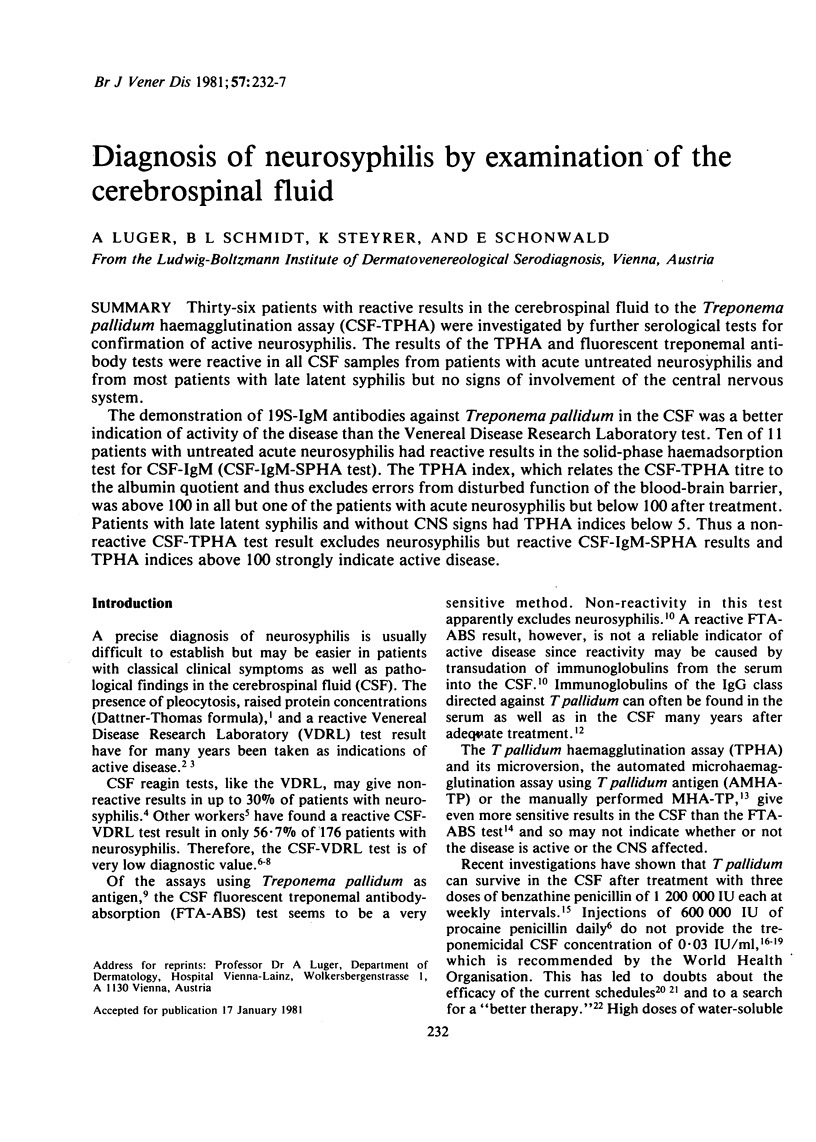
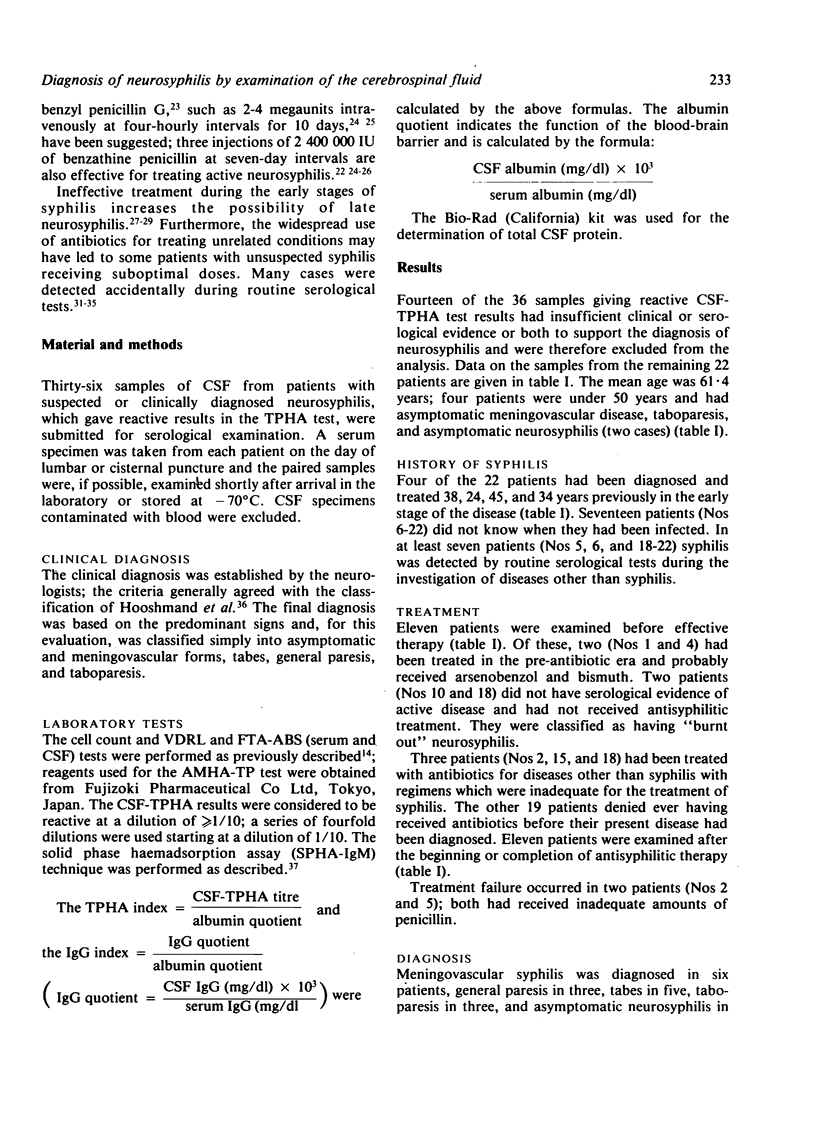
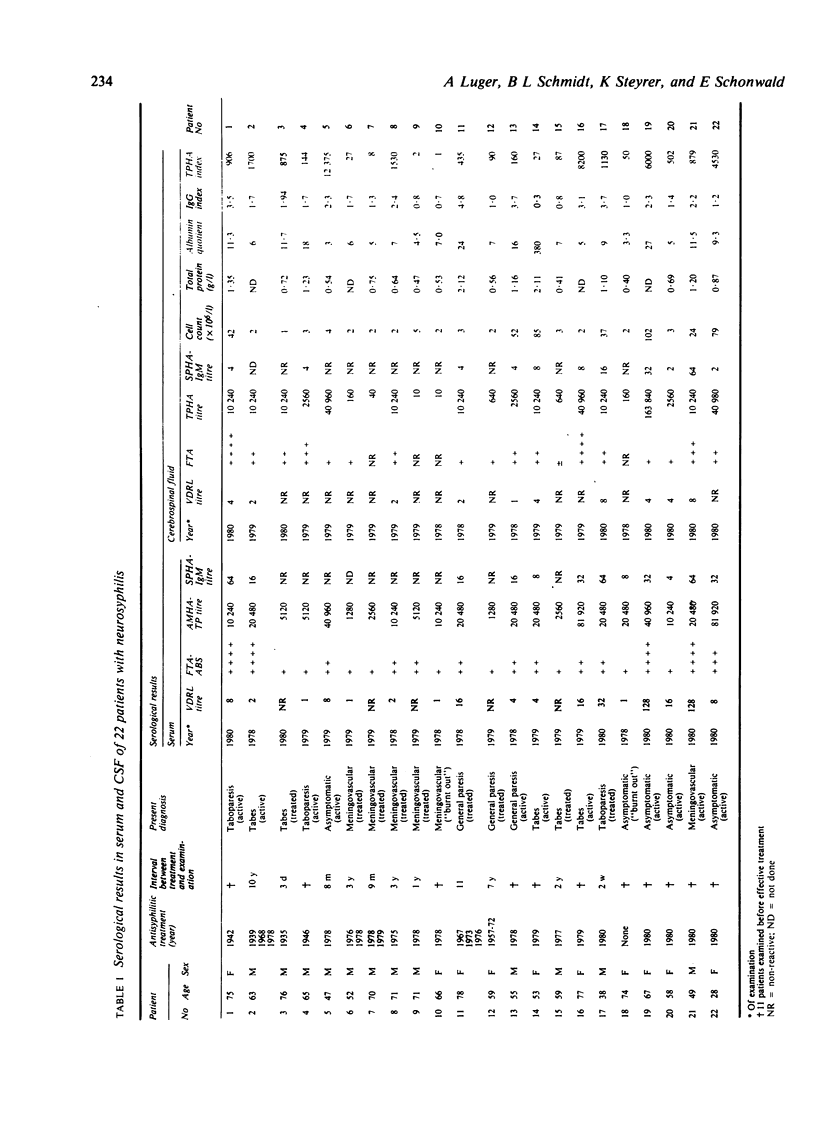
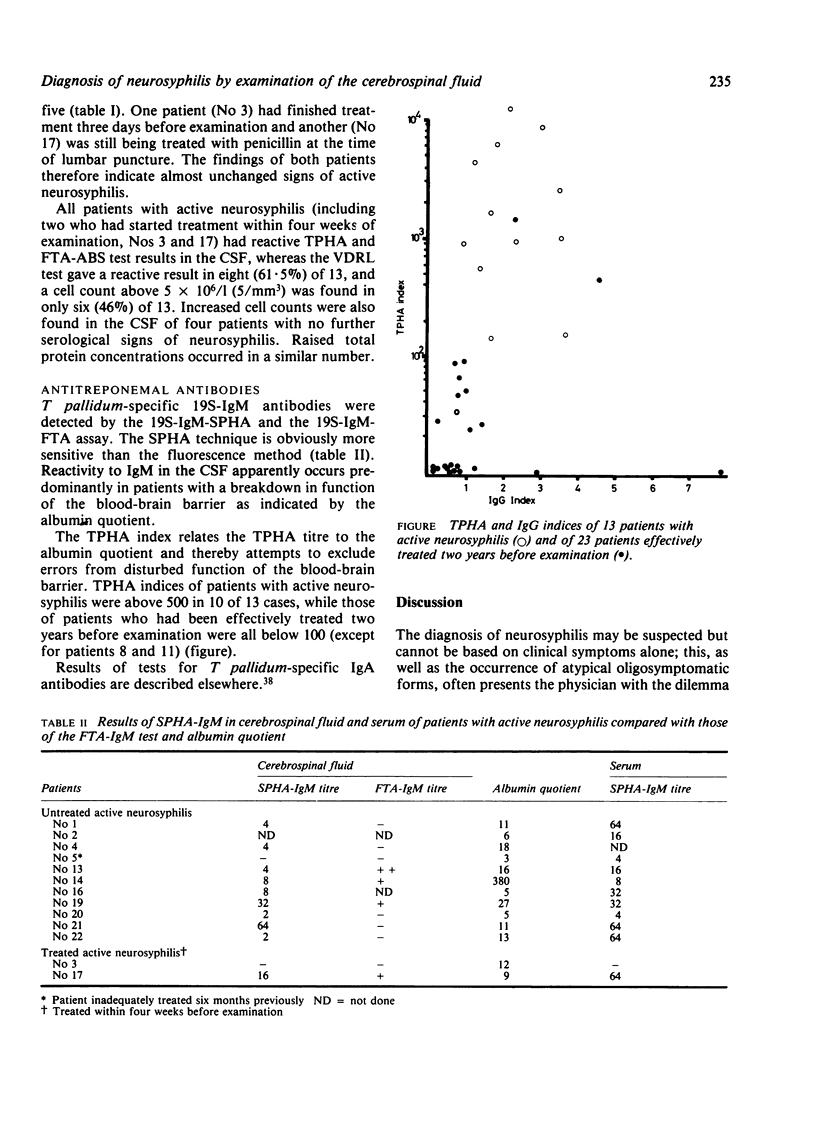
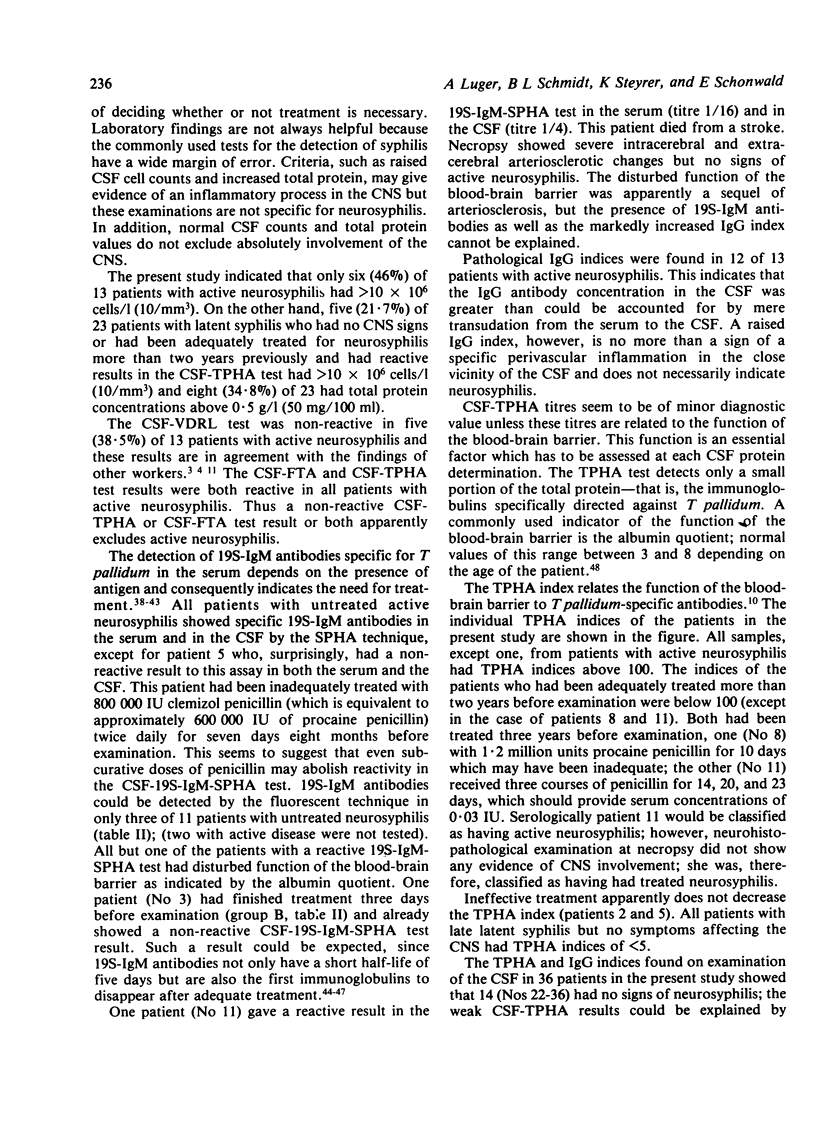
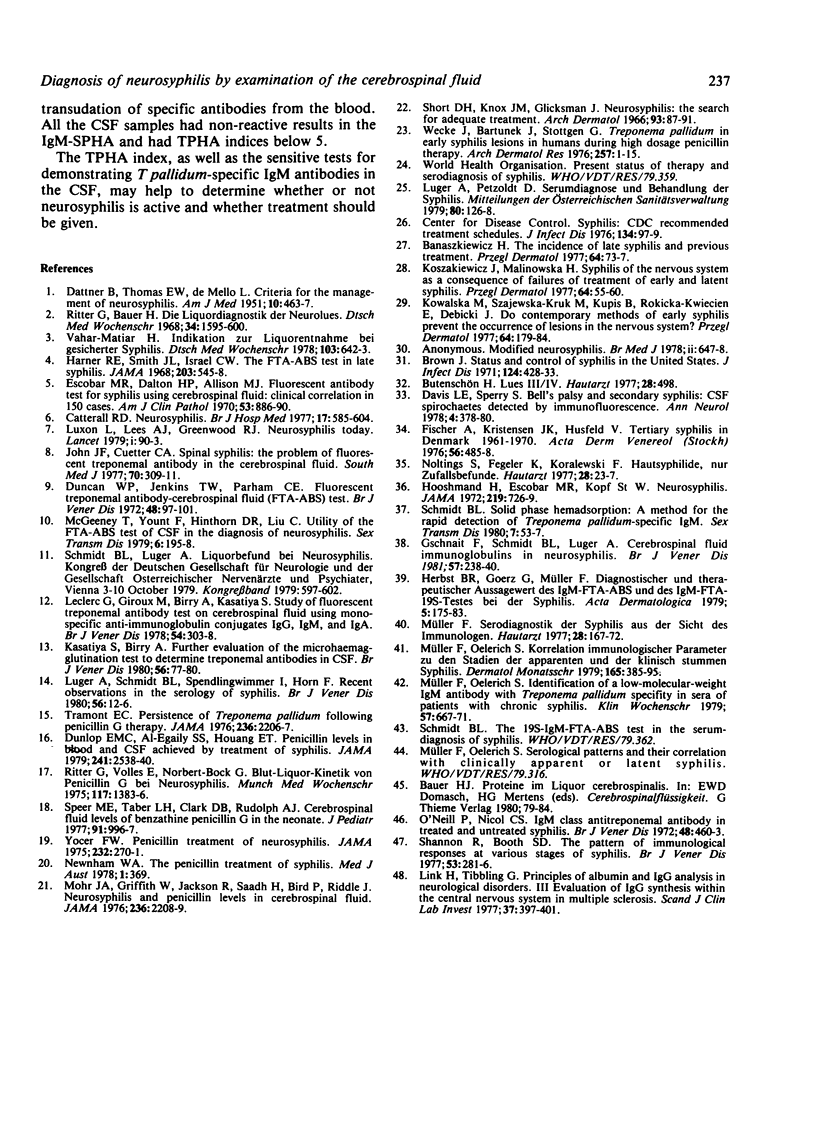
Selected References
These references are in PubMed. This may not be the complete list of references from this article.
- Banaszkiewicz H. Wystepowanie kiły pónej a prezebyte leczenie. Przegl Dermatol. 1977;64(1):73–77. [PubMed] [Google Scholar]
- Catterall R. D. Neurosyphilis. Br J Hosp Med. 1977 Jun;17(6):585–604. [PubMed] [Google Scholar]
- DATTNER B., THOMAS E. W., DE MELLO L. Criteria for the management of neurosyphilis. Am J Med. 1951 Apr;10(4):463–467. doi: 10.1016/0002-9343(51)90292-6. [DOI] [PubMed] [Google Scholar]
- Davis L. E., Sperry S. Bell's palsy and secondary syphilis: CSF spirochetes detected by immunofluorescence. Ann Neurol. 1978 Oct;4(4):378–380. doi: 10.1002/ana.410040416. [DOI] [PubMed] [Google Scholar]
- Duncan W. P., Jenkins T. W., Parham C. E. Fluorescent treponemal antibody-cerebrospinal fluid (FTA-CSF) test. A provisional technique. Br J Vener Dis. 1972 Apr;48(2):97–101. doi: 10.1136/sti.48.2.97. [DOI] [PMC free article] [PubMed] [Google Scholar]
- Dunlop E. M., Al-Egaily S. S., Houang E. T. Penicillin levels in blood and CSF achieved by treatment of syphilis. JAMA. 1979 Jun 8;241(23):2538–2540. [PubMed] [Google Scholar]
- Escobar M. R., Dalton H. P., Allison M. J. Fluorescent antibody tests for syphilis using cerebrospinal fluid: clinical correlation in 150 cases. Am J Clin Pathol. 1970 Jun;53(6):886–890. doi: 10.1093/ajcp/53.6.886. [DOI] [PubMed] [Google Scholar]
- Gschnait F., Schmidt B. L., Luger A. Cerebrospinal fluid immunoglobulins in neurosyphilis. Br J Vener Dis. 1981 Aug;57(4):238–240. doi: 10.1136/sti.57.4.238. [DOI] [PMC free article] [PubMed] [Google Scholar]
- Harner R. E., Smith J. L., Israel C. W. The FTA-ABS test in late syphilis. A serological study in 1,985 cases. JAMA. 1968 Feb 19;203(8):545–548. [PubMed] [Google Scholar]
- Hooshmand H., Escobar M. R., Kopf S. W. Neurosyphilis. A study of 241 patients. JAMA. 1972 Feb;219(6):726–729. doi: 10.1001/jama.219.6.726. [DOI] [PubMed] [Google Scholar]
- John J. F., Jr, Cuetter A. C. Spinal syphilis: the problem of fluorescent treponemal antibody in the cerebrospinal fluid. South Med J. 1977 Mar;70(3):309–311. [PubMed] [Google Scholar]
- Kasatiya S., Birry A. Further evaluation of the microhaemagglutination test to determine treponemal antibodies in CSF. Br J Vener Dis. 1980 Apr;56(2):77–80. doi: 10.1136/sti.56.2.77. [DOI] [PMC free article] [PubMed] [Google Scholar]
- Kowalska M., Szajewska-Kruk M., Kupis B., Rokicka-Kwiecień E., Debicki J. Czy wspóczesne metody leczenia kiły wczesnej zapobiegaja zmianom w układzie nerwowym. Przegl Dermatol. 1977 Mar-Apr;64(2):179–184. [PubMed] [Google Scholar]
- Kozakiewicz J., Malinowska H. Kiła układu nerwowego jako nastepstwo niepowodzeń leczenia kiły wczesnej i utajonej. Przegl Dermatol. 1977;64(1):55–60. [PubMed] [Google Scholar]
- Leclerc G., Giroux M., Birry A., Kasatiya S. Study of fluorescent treponemal antibody test on cerebrospinal fluid using monospecific anti-immunoglobulin conjugates IgG, IgM, and IgA. Br J Vener Dis. 1978 Oct;54(5):303–308. [PMC free article] [PubMed] [Google Scholar]
- Link H., Tibbling G. Principles of albumin and IgG analyses in neurological disorders. III. Evaluation of IgG synthesis within the central nervous system in multiple sclerosis. Scand J Clin Lab Invest. 1977 Sep;37(5):397–401. doi: 10.1080/00365517709091498. [DOI] [PubMed] [Google Scholar]
- Luger A., Schmidt B., Spendlingwimmer I., Horn F. Recent observations on the serology of syphilis. Br J Vener Dis. 1980 Feb;56(1):12–16. doi: 10.1136/sti.56.1.12. [DOI] [PMC free article] [PubMed] [Google Scholar]
- Luxon L., Lees A. J., Greenwood R. J. Neurosyphilis today. Lancet. 1979 Jan;1(8107):90–93. doi: 10.1016/s0140-6736(79)90074-6. [DOI] [PubMed] [Google Scholar]
- McGeeney T., Yount F., Hinthorn D. R., Liu C. Utility of the FTA-Abs test of cerebrospinal fluid in the diagnosis of neurosyphilis. Sex Transm Dis. 1979 Jul-Sep;6(3):195–198. doi: 10.1097/00007435-197907000-00001. [DOI] [PubMed] [Google Scholar]
- Mohr J. A., Griffiths W., Jackson R., Saadah H., Bird P., Riddle J. Neurosyphilis and penicillin levels in cerebrospinal fluid. JAMA. 1976 Nov 8;236(19):2208–2209. [PubMed] [Google Scholar]
- Müller F., Oelerich S. Identification of a low moleculr weight IgM antibody with treponema pallidum specificity in sera of patients with chronic syphilis. Klin Wochenschr. 1979 Jul 3;57(13):667–671. doi: 10.1007/BF01477667. [DOI] [PubMed] [Google Scholar]
- Müller F., Oelerich S. Korrelation immunologischer Parameter zu den Stadien der apparenten und er klinisch stummen Syphilis. Dermatol Monatsschr. 1979 Jun;165(6):385–395. [PubMed] [Google Scholar]
- Müller F. Serodiagnostik der Syphilis aus der Sicht des Immunologen. Hautarzt. 1977 Apr;28(4):167–172. [PubMed] [Google Scholar]
- Newnham W. A. The penicillin treatment of syphilis. Med J Aust. 1978 Apr 8;1(7):369–369. doi: 10.5694/j.1326-5377.1978.tb107909.x. [DOI] [PubMed] [Google Scholar]
- Nolting S., Fegeler K., Koralewski F. Hutsyphilide, nur Zufallsbefunde. Hautarzt. 1977 Jan;28(1):23–27. [PubMed] [Google Scholar]
- O'Neill P., Nicol C. S. IgM class antitreponemal antibody in treated and untreated syphilis. Br J Vener Dis. 1972 Dec;48(6):460–463. doi: 10.1136/sti.48.6.460. [DOI] [PMC free article] [PubMed] [Google Scholar]
- Ritter G., Bauer H. Die Liquordiagnostik der Neurolues. Dtsch Med Wochenschr. 1968 Aug 23;93(34):1595–passim. doi: 10.1055/s-0028-1110794. [DOI] [PubMed] [Google Scholar]
- Ritter G., Volles E., Müller F., Nabert-Bock G. Blut-Liquor-Kinetik von Penicillin-G bei Neurosyphilis. MMW Munch Med Wochenschr. 1975 Aug 29;117(35):1383–1386. [PubMed] [Google Scholar]
- Schmidt B. L. Solid-hase hemadsorption: a method for rapid detection of Treponema pallidum-specific IgM. Sex Transm Dis. 1980 Apr-Jun;7(2):53–58. [PubMed] [Google Scholar]
- Shannon R., Booth S. D. The pattern of immunological responses at various stages of syphilis. Br J Vener Dis. 1977 Oct;53(5):281–286. doi: 10.1136/sti.53.5.281. [DOI] [PMC free article] [PubMed] [Google Scholar]
- Short D. H., Knox J. M., Glicksman J. Neurosyphilis, the search for adequate treatment. A review and report of a study using benzathine penicillin G. Arch Dermatol. 1966 Jan;93(1):87–91. [PubMed] [Google Scholar]
- Speer M. E., Taber L. H., Clark D. B., Rudolph A. J. Cerebrospinal fluid levels of benzathine penicillin G in the neonate. J Pediatr. 1977 Dec;91(6):996–997. doi: 10.1016/s0022-3476(77)80914-1. [DOI] [PubMed] [Google Scholar]
- Tramont E. C. Persistence of Treponema pallidum following penicillin G therapy. Report of two cases. JAMA. 1976 Nov 8;236(19):2206–2207. [PubMed] [Google Scholar]
- Vahar-Matiar H. Indikationen zur Liquorentnahme bei gesicherter Syphilis. Dtsch Med Wochenschr. 1978 Apr 14;103(15):642–643. doi: 10.1055/s-0028-1104490. [DOI] [PubMed] [Google Scholar]
- Wecke J., Bartunek J., Stüttgen G. Treponema pallidum in early syphilitic lesions in humans during high-dosage penicillin therapy. An electron microscopical study. Arch Dermatol Res. 1976 Nov 26;257(1):1–15. doi: 10.1007/BF00569109. [DOI] [PubMed] [Google Scholar]
- Yoder F. W. Penicillin treatment of neurosyphilis. Are recommended dosages sufficient? JAMA. 1975 Apr 21;232(3):270–271. [PubMed] [Google Scholar]


